Building a new version of our software was a journey, and we are so glad to deliver it to our customers.
Our development team has been hard at work over the past 18 months adding and updating more than 1500 elements of SmartMoving. 😳 Yeah, that's a big number!
At SmartMoving, we are committed to building new features to support the moving industry. Innovation is key to making sure that our customers have what they need to drive their businesses forward. A revamp like version 2.0 is a huge undertaking, and we’d like to take a moment to look back and share parts of the journey with you.
Why did we decide to update our software?
There are a lot of reasons to make upgrades to existing software. Overall, adding new software features can help companies to attract and retain customers, stay in line with the market, and improve the overall user experience.
In our case at SmartMoving, the decision to move to a 2.0 version of our software came over time. When we created SmartMoving 1.0, our customers would make feature requests and we built upon the framework we had. For a time, we were able to build these features into our 1.0 version- but then we realized, there were some big changes we wanted to make to meet the needs of customers and better serve the moving industry.
Enter- the idea of a new software framework. Creating SmartMoving 2.0 was to deliver two major solutions:
- A framework built for growth – keeping things faster, seamless, and able to adapt to increased data.
- Solve pain points for our users and give them options on how to structure the software around their business needs
With a huge project like this, where do you start?
First, thinking from the ground up and doing research. What were our customers facing? What key industry changes did we need to consider?
From that exercise, we had to roadmap out a plan that would hit our customers' needs better than the original design. Taking customer feedback into consideration, we started with the biggest lift- updates to our pricing engine.
Starting in 2021 with a lean team of 3-4 developers, we created a new control library for UI that lets us move faster and makes things behave well across the organization. Once that initial step was ready, we had to shift our focus on getting the tariff system right.
The revamp of the tariff system drives 2.0 at its core, so we started with setting up rules and options that we wanted to configure across the platform. Tariffs are critical to how the moving industry works, so getting all our rating costs in one spot was important.
“Once we created the first of the new pricing slide outs, we saw it was so much cleaner to implement than 1.0. That gave me and the team encouragement to keep going” -Matt Honeycutt, CTO
Moving forward with powerful changes
Sometimes there's just a tweak or added feature, and sometimes there's a big adjustment.
Building a 2.0 platform allowed us to add tons of customizations to pricing and estimates that 1.0 couldn’t support, such as fee structures for local/intrastate moves, peak and off-peak pricing, and more. These were all incorporated into a rules-based estimate engine. That engine also added criteria for setting up charge fees, handicaps and support for long distance move pricing. By setting up these different rules in the auto pricing engine, our customers are able to eliminate errors and ensure they never forget to add the appropriate fees.
“One thing I was excited to build out was separation between estimated charges and actual charges within 2.0. We had some shared data in 1.0 and it made things a bit more confusing, so this keeps customer data more organized.” -Robert Simmons, Engineering
Once the pricing structures were created, we spent 2022 building out accounting, sales, opportunity and storage updates. We wanted to overhaul and improve all areas of the existing platform for our customers. Setting up a new version of the software gave us the means to do that.
For more information on what is new in 2.0, read more here.
What were the biggest challenges?
Aside from the project being a huge undertaking spanning a couple years, our team did face some challenges that they had to overcome. Typical in a large build, we knew that a massive launch would require a lot of testing and QA work.
To support this, we spent many hours testing and even ran a Beta program in Summer 2022 where we collected feedback and added support for the growing platform.
The other main challenge was making sure the transition between software versions was mapped out. We wanted to ensure that 1.0 activities would be translated to an equivalent in 2.0 so our customers could translate their activities into the new system. Considering UI was also important, as we didn’t want to overcomplicate previously simple tasks.
Change can be tough. To support the transition, our customer success team has created resources to support our customers.
- We’ve added weekly live trainings.
- Search for support articles in our help center.
- Customers can also contact their customer success manager for assistance.
Bringing innovation to the moving industry helps make our customers market leaders. We are excited for what our team has been able to accomplish with 2.0 and can’t wait for the next projects we release.
















